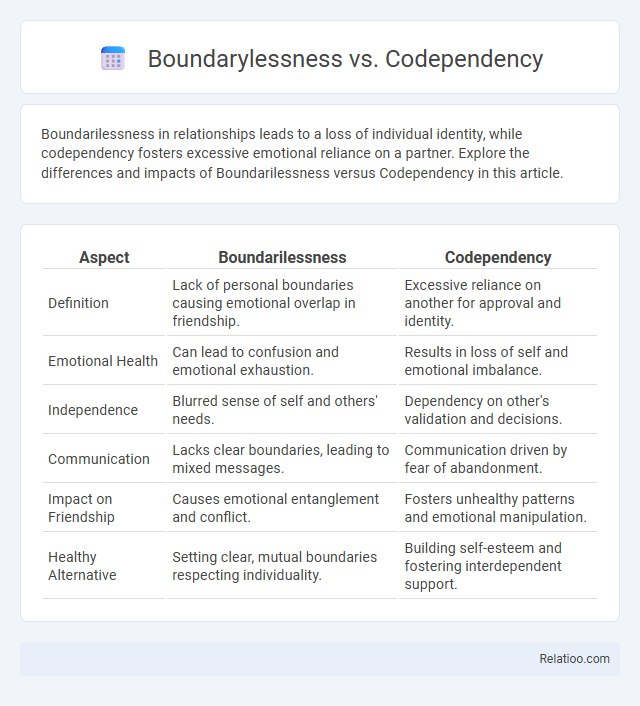Boundarilessness in relationships leads to a loss of individual identity, while codependency fosters excessive emotional reliance on a partner. Explore the differences and impacts of Boundarilessness versus Codependency in this article.
Table of Comparison
| Aspect | Boundarilessness | Codependency |
|---|---|---|
| Definition | Lack of personal boundaries causing emotional overlap in friendship. | Excessive reliance on another for approval and identity. |
| Emotional Health | Can lead to confusion and emotional exhaustion. | Results in loss of self and emotional imbalance. |
| Independence | Blurred sense of self and others' needs. | Dependency on other's validation and decisions. |
| Communication | Lacks clear boundaries, leading to mixed messages. | Communication driven by fear of abandonment. |
| Impact on Friendship | Causes emotional entanglement and conflict. | Fosters unhealthy patterns and emotional manipulation. |
| Healthy Alternative | Setting clear, mutual boundaries respecting individuality. | Building self-esteem and fostering interdependent support. |
Understanding Boundarilessness: Definition and Signs
Boundarilessness refers to a lack of clear personal boundaries, where individuals struggle to define their limits in relationships, often leading to enmeshment or emotional overinvolvement. Key signs include difficulty saying no, taking on others' emotions excessively, and feeling overwhelmed by others' needs. Differentiating boundarilessness from codependency involves recognizing that codependency includes a compulsive need to care for others to maintain self-worth, whereas boundarilessness centers on blurred personal limits and identity confusion.
What Is Codependency? Key Characteristics
Codependency is a dysfunctional behavioral pattern where individuals excessively rely on others for emotional support and approval, often neglecting their own needs and boundaries. Key characteristics include low self-esteem, a strong need for control, difficulty saying no, and an intense fear of abandonment or rejection. Unlike boundarilessness, which involves a lack of clear boundaries, codependency specifically involves unhealthy attachment and enabling behaviors in relationships.
The Roots: How Boundarilessness and Codependency Develop
Boundarilessness and codependency both stem from early developmental experiences marked by inconsistent or unmet emotional needs, often within dysfunctional family dynamics. Boundarilessness arises when individuals struggle to establish clear personal limits due to blurred identity or fear of rejection, while codependency develops from excessive caretaking behaviors driven by a need for approval and control to manage relational instability. Understanding these roots aids in differentiating the lack of healthy boundaries in boundarilessness from the compulsive enabling patterns seen in codependency.
Emotional Consequences: Boundarilessness vs Codependency
Boundarilessness leads to emotional exhaustion and confusion as personal limits become blurred, causing you to lose your sense of self. Codependency, characterized by excessive emotional reliance on others, often results in feelings of anxiety, resentment, and low self-worth. Understanding the emotional consequences of these behaviors is crucial for fostering healthy relationships and emotional well-being.
Impact on Relationships: Healthy Boundaries vs Enmeshment
Healthy boundaries promote respect and autonomy in relationships, enabling you to maintain individuality while fostering connection. Codependency blurs these boundaries, leading to excessive reliance on others for validation and emotional support, which can cause imbalance and resentment. Boundarilessness, or enmeshment, results in a loss of personal identity and independence, often creating unhealthy dependence and emotional entanglement that undermines relationship stability.
Self-Identity and Self-Worth in Both Patterns
Boundarilessness and codependency both erode your self-identity by blurring personal boundaries, yet boundarilessness often involves a lack of clear limits, leading to confusion about self, whereas codependency centers on excessive emotional reliance on others for self-worth. In boundarilessness, diminished self-worth arises from not valuing personal needs, while codependency fosters self-worth solely through approval and validation from others. Understanding these patterns is vital for reclaiming autonomy and cultivating a stable, intrinsic sense of self-identity and self-worth.
Recognizing the Warning Signs in Yourself and Others
Recognizing the warning signs of boundarilessness includes difficulty saying no, emotional exhaustion, and blurred personal limits, while codependency often manifests as excessive people-pleasing, fear of abandonment, and sacrificing own needs for others. In contrast, healthy boundaries involve clear communication, self-respect, and balanced relationships, helping to distinguish between these patterns. Observing behaviors such as over-involvement, lack of autonomy, and emotional enmeshment can signal when someone is struggling with either boundarilessness or codependency.
Breaking the Cycle: Setting Healthy Boundaries
Breaking the cycle of boundarilessness and codependency requires establishing clear, healthy boundaries that promote self-respect and mutual respect in relationships. Boundarilessness often manifests as a lack of personal limits, leading to emotional exhaustion, while codependency involves excessive reliance on others for approval and identity. Setting firm boundaries helps individuals regain autonomy, reduces enabling behaviors, and fosters balanced, supportive connections.
Healing Strategies: From Codependency to Self-Empowerment
Healing strategies from codependency to self-empowerment center on establishing clear personal boundaries and developing emotional autonomy. Techniques such as assertiveness training, cognitive-behavioral therapy, and mindfulness practices help individuals recognize and respect their own needs while preventing enmeshment. Emphasizing self-awareness and self-compassion facilitates the transition from unhealthy dependence to balanced interdependence and authentic self-empowerment.
Building Balanced Relationships: Moving Beyond Extremes
Building balanced relationships requires recognizing the difference between boundarilessness and codependency, where boundarilessness involves a lack of personal boundaries leading to enmeshment, while codependency centers on excessive reliance on others for validation. Establishing clear, healthy boundaries promotes mutual respect and autonomy, preventing emotional exhaustion and enabling authentic connections. Moving beyond these extremes fosters resilience and emotional intelligence essential for sustainable relational dynamics.

Infographic: Boundarilessness vs Codependency
 relatioo.com
relatioo.com